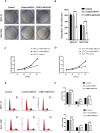CtBP2 overexpression promotes tumor cell proliferation and invasion in gastric cancer and is associated with poor prognosis
- PMID: 28404932
- PMCID: PMC5438687
- DOI: 10.18632/oncotarget.15661
CtBP2 overexpression promotes tumor cell proliferation and invasion in gastric cancer and is associated with poor prognosis
Abstract
C-terminal binding protein-2 (CtBP2), a transcriptional corepressor, has been reported to correlate with tumorigenesis and progression and predict a poor prognosis in several human cancers. However, few studies on CtBP2 in gastric cancer (GC) have been performed. In this research, we evaluated the correlations between CtBP2 expression and the clinicopathological characteristics, as well as prognosis of GC patients. The effects of silencing CtBP2 expression on GC cells biology activity were also assessed. The results showed that CtBP2 was overexpressed in GC tissues and closely correlated with poor differentiation, advanced tumor stage and poor prognosis in GC patients. CtBP2 induced epithelial-to-mesenchymal transition (EMT) and repressed PTEN to increase proliferation rate, migration, and invasion in GC cells. Silencing CtBP2 inhibited GC growth in nude mice model. In conclusion, CtBP2 is overexpressed in GC and may accelerate GC tumorigenesis and metastasis, which could represent an independent prognostic marker and promising therapeutic target for GC.
Keywords: CtBP2; gastric cancer; prognosis.
Conflict of interest statement
The authors declare that they have no conflict of interests
Figures






References
-
- Bang YJ, Van Cutsem E, Feyereislova A, Chung HC, Shen L, Sawaki A, Lordick F, Ohtsu A, Omuro Y, Satoh T, Aprile G, Kulikov E, Hill J, et al. Trastuzumab in combination with chemotherapy versus chemotherapy alone for treatment of HER2-positive advanced gastric or gastro-oesophageal junction cancer (ToGA): a phase 3, open-label, randomised controlled trial. Lancet. 2010;376:687–97. doi: 10.1016/S0140-6736(10)61121-x. - DOI - PubMed
MeSH terms
Substances
LinkOut - more resources
Full Text Sources
Other Literature Sources
Medical
Research Materials
Miscellaneous

